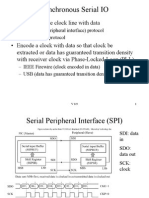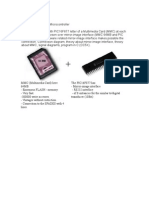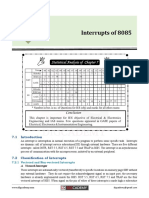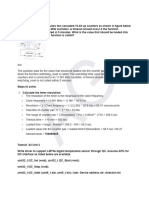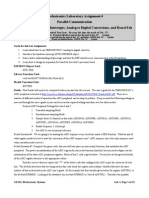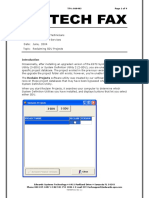Lab # 4
Lab # 4
Uploaded by
inzamamCopyright:
Available Formats
Lab # 4
Lab # 4
Uploaded by
inzamamCopyright
Available Formats
Share this document
Did you find this document useful?
Is this content inappropriate?
Copyright:
Available Formats
Lab # 4
Lab # 4
Uploaded by
inzamamCopyright:
Available Formats
Embedded Systems Lab # 4 MTE-409
Objective:
Introduction to I2C Protocol. Configuration of I2C registers for communication.
Apparatus:
i. PIC 16F877A
ii. Resistor (1 kΩ)
iii. I2C Debugger
Softwares:
i. MPLABX IDE
ii. XC8 compiler
iii. Proteus.
Theory:
1) I2C Communication:
I²C (Inter-Integrated Circuit), is a multi-master, multi-slave, packet switched, single-ended, serial
computer bus invented in 1982 by Philips. The I2C bus is a bi-directional two-wire serial bus that provides
a communication link between integrated circuits. It is a synchronous protocol that allows a master device
to initiate communication with a slave device. Data is exchanged one bit at a time.
The two wires, or lines are called Serial Clock (or SCL) and Serial Data (or SDA). The SCL line is the
clock signal line, generated by the master which synchronize the data transfer between the devices on the
I2C bus. The other line is the SDA line which carries the data.
Both the lines are “open-drain” which means that pull up resistors needs to be attached to them so that
the lines are high because the devices on the I2C bus are active low. Commonly used values for the resistors
are from 2k for higher speeds at about 400 kbps, to 10k for lower speed at about 100 kbps. The I2C mode
fully implements all master and slave functions and provides interrupts on Start and Stop bits in hardware
to determine a free bus (multi-master function). It supports 7-bit and 10-bit addressing and can connect up
to 127 devices with only two wires. The user must configure these pins as inputs or outputs.
a) Master:
A device on the I2C bus which starts the communication.
b) Slave:
A device which is being addressed by Master.
2) Protocol:
The data signal is transferred in sequences of 8-bits. So, after a special start condition occurs comes the
first 8-bits sequence which indicates the address of the slave to which the data is being sent. The device
addressing sequence starts with the most significant bit (MSB) first and ends with the least significant bit
(LSB) and it’s actually composed of 7 bits because the 8th bit is used for indicating whether the master will
write to the slave (logic low) or read from it (logic high). After each 8-bits sequence follows a bit called
Acknowledge. After the first Acknowledge bit in most cases comes another addressing sequence but this
Attique Ur Rehman (17-003) Page # 1
Embedded Systems Lab # 4 MTE-409
time for the internal registers of the slave device. After the addressing sequences follows the data sequences
as many until the data is completely sent and it ends with a special stop condition.
I2C communication can only start if the bus is idle.
3) Register:
The MSSP module has six registers for I2C operation. These are:
i. MSSP Control Register (SSPCON)
ii. MSSP Control Register 2 (SSPCON2)
iii. MSSP Status Register (SSPSTAT)
iv. Serial Receive/Transmit Buffer Register (SSPBUF)
v. MSSP Shift Register (SSPSR) – Not directly accessible
vi. MSSP Address Register (SSPADD)
SSPCON, SSPCON2 and SSPSTAT are the control and status registers in I2C mode operation. The
SSPCON and SSPCON2 registers are readable and writable. The lower six bits of the SSPSTAT are read-
only. The upper two bits of the SSPSTAT are read/write. SSPSR is the shift register used for shifting data
in or out. SSPBUF is the buffer register to which data bytes are written to or read from. SSPADD register
holds the slave device address when the SSP is configured in I2C Slave mode.
When the SSP is configured in Master mode, the lower seven bits of SSPADD act as the baud rate
generator reload value. In receive operations, SSPSR and SSPBUF together create a double-buffered
receiver. When SSPSR receives a complete byte, it is transferred to SSPBUF and the SSPIF interrupt is set.
During transmission, the SSPBUF is not double buffered. A write to SSPBUF will write to both SSPBUF
and SSPSR.
Attique Ur Rehman (17-003) Page # 2
Embedded Systems Lab # 4 MTE-409
4) Register Configuration:
Attique Ur Rehman (17-003) Page # 3
Embedded Systems Lab # 4 MTE-409
Attique Ur Rehman (17-003) Page # 4
Embedded Systems Lab # 4 MTE-409
Attique Ur Rehman (17-003) Page # 5
Embedded Systems Lab # 4 MTE-409
5) Timing Diagram:
Attique Ur Rehman (17-003) Page # 6
Embedded Systems Lab # 4 MTE-409
6) Calculation:
Fosc = 20 MHz
Clock = 20 kHz
𝐹𝑜𝑠𝑐
Clock =
(4 ∗ (𝑆𝑆𝑃𝐴𝐷𝐷 + 1))
SSPADD = 249
7) Code:
#define _XTAL_FREQ 20000000
#include <xc.h>
__PROG_CONFIG(0,0x3F32);
/*****************************Functions Declaration****************************/
unsigned char I2C_Init(void);
unsigned char Start_I2C(void);
unsigned char Stop_I2C(void);
unsigned char Rep_Start_Cond();
unsigned char Ack_Stat();
unsigned char Ack_Event(unsigned char state);
unsigned char Trans_Byte(unsigned char data);
unsigned char Recv_Byte(void);
/******************************************************************************/
/*********************************Main Program*********************************/
void main(void)
{
//Initialize the I2C communication
I2C_Init();
//Generate the Start condition
Start_I2C();
//Send the address frame
Trans_Byte(0xD0);
//Now check for Acknowledge from the slave
if(!Ack_Stat())
{
Rep_Start_Cond();
//Wait for few milliseconds
__delay_ms(10);
//Again send the slave address
Trans_Byte(0xD0);
}
Attique Ur Rehman (17-003) Page # 7
Embedded Systems Lab # 4 MTE-409
//If Acknowledge is received then send register address
else
Trans_Byte(0xA1);
//Again check for Acknowledge
if(!Ack_Stat())
{
Rep_Start_Cond();
//Wait for few milliseconds
__delay_ms(10);
//Again send the register address
Trans_Byte(0xA1);
}
//If Acknowledge is received then send receive data from the slave
else
Recv_Byte();
//Stop the I2c Communication
Stop_I2C();
while(1);
return;
}
/******************************************************************************/
/********************************Function Definition***************************/
unsigned char I2C_Init(void)
{
//Make SDA, SCL pins as input or output. In our case, we are making them inputs.
TRISCbits.TRISC3 = 1;
TRISCbits.TRISC4 = 1;
//Configuring PIC16F877A in Master mode,
//Configuring and enabling the pins as serial port pins (SSPEN = 1)
SSPCONbits.SSPEN = 1;
//I2C master mode SSPM3 - SSPM0 = 1000.
SSPCONbits.SSPM = 8;
//Disabling the specific SMBUS inputs
SSPSTATbits.CKE = 0;
//Disabling the Slew rate speed for standard mode
SSPSTATbits.SMP = 1;
//Also find the SSPADD value by using given formula.
SSPADD = 249;
}
/******************************************************************************/
Attique Ur Rehman (17-003) Page # 8
Embedded Systems Lab # 4 MTE-409
unsigned char Start_I2C(void)
{
//Clear the Interrupt Flag
SSPIF = 0;
//Enable the Start condition by enabling the SEN bit
SSPCON2bits.SEN = 1;
//Wait till the start condition is generated . SEN will be cleared and SSPIF will be set automatically by hardware.
//i.e. SEN = 0 and SSPIF = 1.
while(SSPCON2bits.SEN == 1);
while(!SSPIF);
//Again clear the Interrupt Flag
SSPIF = 0;
}
/******************************************************************************/
unsigned char Stop_I2C()
{
//Clear the Interrupt Flag
SSPIF = 0;
//Enable the Start condition by enabling the SEN bit
SSPCON2bits.PEN = 1;
//Wait till the start condition is generated
while(SSPCON2bits.PEN);
while(!SSPIF);
//Again clear the Interrupt Flag
SSPIF = 0;
}
/******************************************************************************/
unsigned char Rep_Start_Cond()
{
//Clearing the interrupt flag
PIR1bits.SSPIF = 0;
//Enabling the Repeated Start condition by making bit RSEN = 1
SSPCON2bits.RSEN = 1;
//Waiting for bit to be cleared by hardware
while(SSPCON2bits.RSEN);
//Waiting for repeated start condition to start
while(PIR1bits.SSPIF!=1);
//Again clearing the interrupt flag
PIR1bits.SSPIF=0;
}
Attique Ur Rehman (17-003) Page # 9
Embedded Systems Lab # 4 MTE-409
/******************************************************************************/
unsigned char Ack_Stat()
{
//No Acknowledge receive if ACKSTAT = 1
if(SSPCON2bits.ACKSTAT)
return(1);
//Acknowledge received if ACKSTAT = 0
else
return(0);
}
/******************************************************************************/
//Sending Acknowledge by Master to slave.
unsigned char Ack_Event(unsigned char state)
{
if(state)
SSPCON2bits.ACKDT = 1; //User wants No ACK
else
SSPCON2bits.ACKDT = 0; //User wants ACK
//Clear Interrupt flag Before transmitting the ACK
PIR1bits.SSPIF = 0;
//Transmit the ACK Bit
SSPCON2bits.ACKEN = 1;
//Wait for completion of transmit of this but
while(SSPCON2bits.ACKEN);
//Wait for interrupt flag to become high
while(PIR1bits.SSPIF!=1);
PIR1bits.SSPIF = 0; // Clear the interrupt flag
return(state);
}
/******************************************************************************/
unsigned char Trans_Byte(unsigned char data)
{
//Clearing the interrupt flag
PIR1bits.SSPIF = 0;
//Shifting data to SSPBUF register
SSPBUF = data;
while(BF);
//Waiting for interrupt flag to become high or '1'
while(PIR1bits.SSPIF!=1);
//Again clearing the interrupt flag
Attique Ur Rehman (17-003) Page # 10
Embedded Systems Lab # 4 MTE-409
PIR1bits.SSPIF = 0;
}
/******************************************************************************/
unsigned char Recv_Byte(void)
{
//Clearing the interrupt flag
PIR1bits.SSPIF=0;
//Enabling the reception of data by making bit RCEN = 1
SSPCON2bits.RCEN=1;
//Waiting for completion of data reception. RCEN will be automatically cleared by hardware to indicate reception
of data
while (SSPCON2bits.RCEN);
//Waiting for interrupt flag to become high
while(!PIR1bits.SSPIF);
//Clearing the interrupt flag
PIR1bits.SSPIF=0;
//Reading the received byte
return(SSPBUF);
}
/******************************************************************************/
8) Software Implementation:
Attique Ur Rehman (17-003) Page # 11
Embedded Systems Lab # 4 MTE-409
Attique Ur Rehman (17-003) Page # 12
Embedded Systems Lab # 4 MTE-409
Attique Ur Rehman (17-003) Page # 13
Embedded Systems Lab # 4 MTE-409
9) Results:
Attique Ur Rehman (17-003) Page # 14
Embedded Systems Lab # 4 MTE-409
Procedure:
i. Firstly, i made the functions for I2C initialization and configured its registers by using datasheet of
PIC16F877A as shown.
ii. I also read the timing diagram of I2C master mode.
iii. Then I made functions for start and stop condition of I2C communication in which we enabled the
start and stop condition by SEN (bit 0) and PEN (bit 1).
iv. Then I made functions for data transmission in which I use SSPBUF register for data write.
v. The status of ACK is written into the ACKDT bit on the falling edge of the ninth clock. If the master
receives an Acknowledge, the Acknowledge Status bit, ACKSTAT, is cleared. If not, the bit is set.
vi. After the ninth clock, the SSPIF bit is set and the master clock is suspended until the next data byte
is loaded into the SSPBUF, leaving SCL low and SDA unchanged.
vii. After this I made circuit diagram in proteus as shown in output and simulated the program.
Conclusion:
In this lab, I have explored, learned and implemented I2C communication protocol. I have learned the
behavior of I2C communication at the beginners level and practiced it.
Attique Ur Rehman (17-003) Page # 15
You might also like
- ARM Microcontrollers Programming for Embedded SystemsFrom EverandARM Microcontrollers Programming for Embedded SystemsRating: 5 out of 5 stars5/5 (1)
- Speeduino Manual PDFDocument58 pagesSpeeduino Manual PDFgiapy0000No ratings yet
- KNX Cookbook v1Document108 pagesKNX Cookbook v1luis9000000% (1)
- Is 13364 2 1992 PDFDocument17 pagesIs 13364 2 1992 PDFAshish DongreNo ratings yet
- 17B I2C ExampleDocument6 pages17B I2C ExampleSusheela SubramaniumNo ratings yet
- 9 I2c-SpiDocument40 pages9 I2c-SpiTam PhamNo ratings yet
- Using The PIC Devices' SSP and MSSP Modules For Slave I2C CommunicationDocument20 pagesUsing The PIC Devices' SSP and MSSP Modules For Slave I2C CommunicationthelutheranknightNo ratings yet
- Ds1307 InterfacingDocument8 pagesDs1307 InterfacinggudduNo ratings yet
- I 2 CDocument48 pagesI 2 CMohit DayalNo ratings yet
- I2c EEPROM FULL CODEDocument24 pagesI2c EEPROM FULL CODESumathi AnandNo ratings yet
- AN3035 - Using The HC08 SCI ModuleDocument8 pagesAN3035 - Using The HC08 SCI ModuleJuan Carlos Suárez BarónNo ratings yet
- Datasheet I2 C1Document200 pagesDatasheet I2 C1HồngHàNo ratings yet
- MCP23008/MCP23S08 8-Bit I/O Expander With Serial Interface - 21919eDocument44 pagesMCP23008/MCP23S08 8-Bit I/O Expander With Serial Interface - 21919eGuillermo Hernandez100% (3)
- Pic Microcontroller 2.1 Pic It Is A Family of Modified Harvard Architecture Microcontrollers MadeDocument16 pagesPic Microcontroller 2.1 Pic It Is A Family of Modified Harvard Architecture Microcontrollers MadeSuresh KumarNo ratings yet
- VE4072-RTES-lab manualDocument34 pagesVE4072-RTES-lab manualharika183nNo ratings yet
- STM32 Tutorial 04 - I2C Module (Pca9685) Using HAL (And FreeRTOS)Document6 pagesSTM32 Tutorial 04 - I2C Module (Pca9685) Using HAL (And FreeRTOS)Quocdt Ngoc100% (1)
- C-Code Software Routines For Using The SPI Interface On The MAX7456 On-Screen DisplayDocument9 pagesC-Code Software Routines For Using The SPI Interface On The MAX7456 On-Screen DisplayVinay Ashwath100% (2)
- Pic18 Serial CommunicationDocument25 pagesPic18 Serial Communicationadamwaiz100% (3)
- Serial Peripheral Interface (SPI)Document12 pagesSerial Peripheral Interface (SPI)ZoranNo ratings yet
- MPMCDocument14 pagesMPMCibnusureshNo ratings yet
- Standard Firmata EthernetDocument34 pagesStandard Firmata Ethernetsoo chiNo ratings yet
- Embedded Systems Communication ProtocolDocument7 pagesEmbedded Systems Communication ProtocolYeabsera YismasewaNo ratings yet
- 13 Serial Sinkron SPI I2CDocument47 pages13 Serial Sinkron SPI I2C092Mutmainnah TulhadawiahNo ratings yet
- Lab0 CDocument5 pagesLab0 CJorge Cruz Mancilla100% (1)
- Sony Sirc ProtocolDocument10 pagesSony Sirc ProtocolFrancisco HernandezNo ratings yet
- LCD RS232 InterfaceDocument2,505 pagesLCD RS232 InterfaceJuan Gil RocaNo ratings yet
- Synchronous Serial IO: - Send A Separate Clock Line With DataDocument42 pagesSynchronous Serial IO: - Send A Separate Clock Line With DataGigi KentNo ratings yet
- Add A DS1307 RTC Clock To Your AVR MicrocontrollerDocument14 pagesAdd A DS1307 RTC Clock To Your AVR MicrocontrolleriburolNo ratings yet
- MCU SolutionDocument73 pagesMCU Solutionayonpc590No ratings yet
- SDA - Serial Data, SCL - Serial ClockDocument10 pagesSDA - Serial Data, SCL - Serial ClockPavan Kulkarni100% (3)
- #Include #Include #Include #Include #IncludeDocument4 pages#Include #Include #Include #Include #Includeshiva1luNo ratings yet
- 64MB MMC and PIC Micro ControllerDocument10 pages64MB MMC and PIC Micro Controllerapi-27535945100% (5)
- 19ecs431 - Embedded SystemsDocument18 pages19ecs431 - Embedded SystemsNaresh KumarNo ratings yet
- How To Write An Industry-Standard EEPROM (24C04) Using The MAX2990 I C InterfaceDocument4 pagesHow To Write An Industry-Standard EEPROM (24C04) Using The MAX2990 I C InterfaceOrcasNo ratings yet
- Embedded Lab 2022 BatchDocument49 pagesEmbedded Lab 2022 BatchGunal RajNo ratings yet
- Using The MSSP Module To Interface I2CDocument16 pagesUsing The MSSP Module To Interface I2Csoft4gsmNo ratings yet
- #Include #Include: "Spi.H" "Digitalio.H"Document6 pages#Include #Include: "Spi.H" "Digitalio.H"api-552271981No ratings yet
- I2CDocument9 pagesI2CPrasanna VenkatesanNo ratings yet
- Section 7.2 - I2CNewMarch27Document32 pagesSection 7.2 - I2CNewMarch27Andy Wo100% (1)
- C51 ADC Program ExamplesDocument22 pagesC51 ADC Program ExamplesplcmanaNo ratings yet
- Project Templet REPORTDocument15 pagesProject Templet REPORTHcv Prasad KacharlaNo ratings yet
- Application Note, Nordic nRF24L01 With Bascom-AvrDocument8 pagesApplication Note, Nordic nRF24L01 With Bascom-AvrLalinda Rathnabharatie100% (2)
- Spot ProtocolDocument12 pagesSpot Protocolj_pozo_c209No ratings yet
- 24C64WPDocument15 pages24C64WPaldo_suviNo ratings yet
- ST24 25C04, ST24 25W04Document16 pagesST24 25C04, ST24 25W04Zoran KovacevicNo ratings yet
- TX & RX Sample CodeDocument8 pagesTX & RX Sample CodeMadianita EstradaNo ratings yet
- AN4481Document17 pagesAN4481Utente UtenteNo ratings yet
- I2C Exmaple ESP 32Document7 pagesI2C Exmaple ESP 32fmsarwarNo ratings yet
- code4Document7 pagescode4h210595vNo ratings yet
- Chapter 7 Interrupts of 8085Document20 pagesChapter 7 Interrupts of 8085shubhankar pal100% (1)
- Embedded Tutorial Solutions-1Document14 pagesEmbedded Tutorial Solutions-1shreyasmi.ec21No ratings yet
- Ge423 Lab4Document13 pagesGe423 Lab4lephuducNo ratings yet
- Lab Serial Communication 8051Document3 pagesLab Serial Communication 8051khawar iqbalNo ratings yet
- ST NDDocument9 pagesST NDsrikaanth3811No ratings yet
- I2c Rev03Document17 pagesI2c Rev03varunmr100% (1)
- ESP8266 - Independent Study - mr945 PDFDocument49 pagesESP8266 - Independent Study - mr945 PDFsaravananNo ratings yet
- Transforming Your AVR Microcontroller To The I2C or TWI Slave I - O Expander Project - ErmicroblogDocument18 pagesTransforming Your AVR Microcontroller To The I2C or TWI Slave I - O Expander Project - Ermicroblogمحمد الد ين الفجرNo ratings yet
- Introduction I2c and SPIDocument14 pagesIntroduction I2c and SPIHaris Jeelani100% (1)
- CAN Bus in PSoC Report210Document16 pagesCAN Bus in PSoC Report210Marcos Antonio EstremoteNo ratings yet
- CISCO PACKET TRACER LABS: Best practice of configuring or troubleshooting NetworkFrom EverandCISCO PACKET TRACER LABS: Best practice of configuring or troubleshooting NetworkNo ratings yet
- Practical Reverse Engineering: x86, x64, ARM, Windows Kernel, Reversing Tools, and ObfuscationFrom EverandPractical Reverse Engineering: x86, x64, ARM, Windows Kernel, Reversing Tools, and ObfuscationNo ratings yet
- PLC: Programmable Logic Controller – Arktika.: EXPERIMENTAL PRODUCT BASED ON CPLD.From EverandPLC: Programmable Logic Controller – Arktika.: EXPERIMENTAL PRODUCT BASED ON CPLD.No ratings yet
- Network with Practical Labs Configuration: Step by Step configuration of Router and Switch configurationFrom EverandNetwork with Practical Labs Configuration: Step by Step configuration of Router and Switch configurationNo ratings yet
- EST Technical FAX TFN: 060403 Page 1 of 4: TSFORM 011 Rev 1.1Document4 pagesEST Technical FAX TFN: 060403 Page 1 of 4: TSFORM 011 Rev 1.1Omar Alfredo Del Castillo QuispeNo ratings yet
- Manual AnalisadorDocument17 pagesManual AnalisadorDavid Fernando Marcucci PicoNo ratings yet
- EssaysDocument10 pagesEssaysasgharNo ratings yet
- LiveStrong Elliptical Service ManualDocument12 pagesLiveStrong Elliptical Service ManualnnNo ratings yet
- Virtual Design and Construction A New CoDocument4 pagesVirtual Design and Construction A New CoEdwin SanchezNo ratings yet
- Manual VSM enDocument41 pagesManual VSM enmuhammadashfaq17No ratings yet
- Kvasar Dreammask: Project FinishedDocument3 pagesKvasar Dreammask: Project FinishedAnurag ChandNo ratings yet
- Linux Shell Programming: Muhammad Farhan Sjaugi (Farhansj@biruni - Upm.my)Document53 pagesLinux Shell Programming: Muhammad Farhan Sjaugi (Farhansj@biruni - Upm.my)Venkat Kiran SribhashyamNo ratings yet
- Accusense ATM2400Document2 pagesAccusense ATM2400Nmshelp C-DOTNo ratings yet
- Mod Menu Crash 2023 08 17-08 45 31Document2 pagesMod Menu Crash 2023 08 17-08 45 310185 Muhammad FauziNo ratings yet
- Uba10-11 SS 28052 Id003 Dom1Document7 pagesUba10-11 SS 28052 Id003 Dom1AlyoNovak100% (1)
- NO / NC Contacts: Program in LAD Program in STLDocument3 pagesNO / NC Contacts: Program in LAD Program in STLNurunNo ratings yet
- API q1 Documents DemoDocument10 pagesAPI q1 Documents DemoJaspreet SinghNo ratings yet
- Aaagang ShiiiiiDocument24 pagesAaagang ShiiiiiAlbin NelaNo ratings yet
- Electromechanical EngDocument18 pagesElectromechanical EngAnonymous gsu1cFNo ratings yet
- Working With The Package: Robot - LocalizationDocument18 pagesWorking With The Package: Robot - LocalizationCoffee ĐenNo ratings yet
- Damerau Levenshtein Algorithm by R - GDocument5 pagesDamerau Levenshtein Algorithm by R - GSambreenNo ratings yet
- 226 Unit-7Document26 pages226 Unit-7shivam saxenaNo ratings yet
- Codes SolutionsDocument41 pagesCodes SolutionsNityam JoshiNo ratings yet
- Dokumen - Tips - Simulation of Ward Leonard Test Set and Induction Motor On Matlab For Teaching PDFDocument10 pagesDokumen - Tips - Simulation of Ward Leonard Test Set and Induction Motor On Matlab For Teaching PDFAmanda FigueiredoNo ratings yet
- Tektronix Inc. Global ErpDocument10 pagesTektronix Inc. Global Erpamit patelNo ratings yet
- Ebook Setup EA Padu Viral v.100Document50 pagesEbook Setup EA Padu Viral v.100Muhd Burhanuddin100% (1)
- CRI - AssignmentDocument27 pagesCRI - Assignmentyew chunNo ratings yet
- MNLG 4Document2 pagesMNLG 4Kanchana Venkatesh39% (18)
- European e Competence Framework 3.0 CEN CWA 16234 1 2014Document53 pagesEuropean e Competence Framework 3.0 CEN CWA 16234 1 2014Justine PaulNo ratings yet
- HPE StoreOnce 3660 80TB Base System-PSN1013350029FIENDocument4 pagesHPE StoreOnce 3660 80TB Base System-PSN1013350029FIENEsperant KayembelukusaNo ratings yet
- 1769 Iq32tDocument20 pages1769 Iq32tHilder Ramirez PuellesNo ratings yet


























